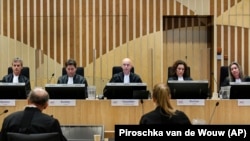On Oct. 15, the Russian state media outlet RT (Russia Today) published an article on the Russian Foreign Ministry’s announcement that it was ending consultations with the governments of The Netherlands and Australia about the crash of Malaysian Airlines flight MH17, which was shot down over eastern Ukraine on July 17, 2014, amid a Russian-initiated secessionist war.
“Russia’s Foreign Ministry believes it’s ‘impossible’ for Moscow to continue consultations with the Netherlands and Australia on the 2014 downing of Malaysia Airlines Flight MH17, as they are not interested in uncovering the truth,” the RT article reads.
“Instead, in a Thursday morning statement, Russian diplomats accused the two countries of seeking only to blame Moscow and arriving at the process with a preconceived outcome.”
The RT article provides background information on the Joint Investigative Team, the multinational organization created to determine the cause of the MH17 crash, which killed all 298 on board, most of them Dutch.
It correctly describes the JIT’s conclusion: “The JIT ruled that Flight MH17 was shot down by a Soviet-made Buk air defense system, and claimed that rebels fighting the post-Maidan government in Kiev, in the Donbass Region, had obtained the system from Russia.”
What follows, however, is distorted: “Moscow insisted that the probe ignored a large batch of data on the crash that Russia was eager to provide, instead relying largely on the evidence from Ukraine, and on ‘open-source’ information such as clips of purported evidence posted on social media. The material in the JIT’s case also lacked crucial data from Ukrainian radars and from photos made by U.S. satellites, which Kiev and Washington respectively said they couldn’t provide.”
Those two sentences include several falsehoods.
The first involves the assertion that Russia was “eager” to provide radar data. Initially, when asked to provide radar data from the time of the crash, Russia did not provide primary, raw data. Instead, it offered a video combining primary and secondary radar data, which it claimed showed a fighter jet flying near MH17.
That data appeared to support one of Russia’s alternative explanations of what happened -- that a Ukrainian military plane shot down the airliner. This hypothesis has been dismissed for technical reasons and based on forensic evidence.
Later, in 2016, Russia provided raw radar data that had originally been requested, and claimed the “fighter jet” they had previously identified in the earlier video had in fact been parts of MH17’s wreckage as the Boeing 777 airliner broke up in air, not another aircraft.
The fact that this shift happened in 2016 is significant. In October 2015, Almaz-Antey, the manufacturer of the Buk M1 surface-to-air-missile (SAM) system, claimed its own investigation concluded MH17 had indeed been shot down by a Buk SAM. (Almaz-Antey also said the missile had been launched from territory controlled by Ukrainian forces, but that turned out to be wrong. Pro-Russian forces controlled the territory at the time of the launch.)
As for Ukraine’s radar data, the only radar station capable of providing that data on July 17, 2014, was, as the JIT confirmed, undergoing scheduled maintenance at the time.
The claim that the U.S. did not turn over satellite images is also false. As Polygraph.info reported in 2018, the head of the JIT confirmed that the U.S. had turned over classified satellite images from the day of the crash in 2014. Some of these images were widely published days after the airliner was downed.
The RT article’s treatment of open source intelligence (OSINT), using quotations around the phrase and dismissing it as “purported evidence posted on social media,” is highly misleading. OSINT material from social media includes photographs and videos, which are generally considered to be legitimate and valuable evidence. And while photographs and videos can be altered, manipulation can be investigated and found out. Both the Russian Ministry of Defense and state media outlets have provided altered or possibly altered photographs related to the MH17 case.
The RT article makes no mention of physical evidence, such as the fragments of the Buk missile and its warhead that were recovered.
Malaysian Airlines flight MH17 was shot down over eastern Ukraine on July 17, 2014, as fighting raged in the area between Ukrainian government forces and Russian-led proxy forces attempting to capture the country’s Donbas region.
The Joint Investigative Team concluded in 2018 that the airliner was shot down by a Buk M1 SAM system belonging to Russia’s 53rd Anti-Aircraft Missile brigade. In 2020, the Dutch government opened a criminal trial in absentia of three Russian nationals and one Ukrainian national charged with causing the deaths of the 298 victims of the disaster.
Russia has categorically denied involvement in the crash and instead has offered various alternate explanations, all of which have been debunked.





